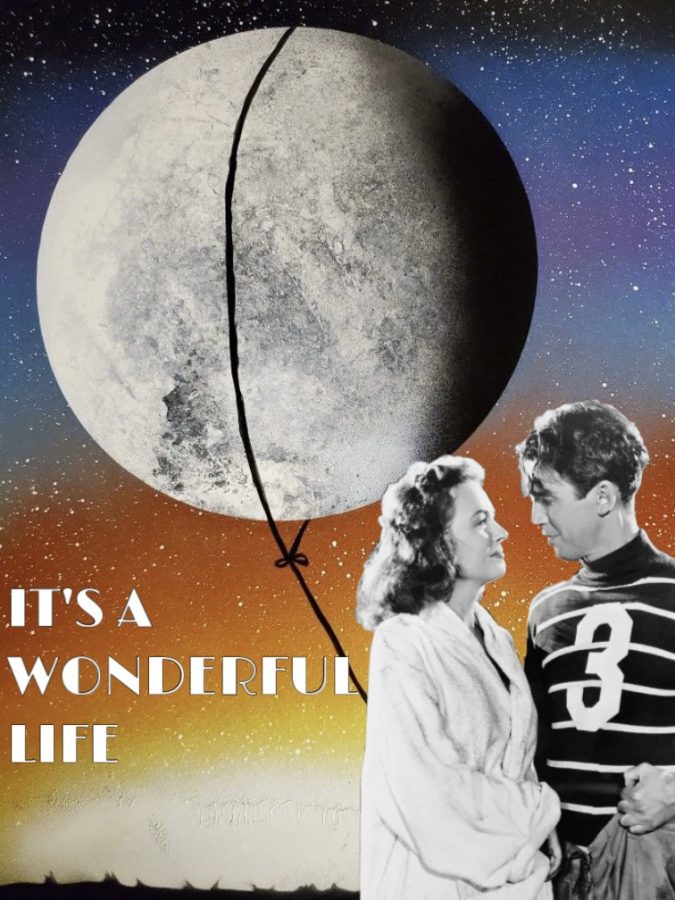It’s a Wonderful Life (1946)
AFI’s Top 100 Movies (1998)
December 11, 2022
Originally a box office flop at the time of its release, Frank Capra’s It’s A Wonderful Life has grown to be considered as one of the greatest films of all time. The film was based on The Greatest Gift, a short story published in 1943, which was roughly based on Charles Dickens’ A Christmas Carol. Themes of sacrifice, individualism, and family tie this account of the life of George Bailey into a timeless, and sentimental film.
It’s Christmas, 1945, in Bedford Falls. Up in the heavens, two angels discuss George Bailey, a man who has found himself in need of divine intervention. Clarence Odbody, a “second class” guardian angel, has been assigned to go to George and provide guidance. Flashbacks of George’s life lead up to the present, beginning with his little brother’s accident. At age twelve, George and his friends were sledding down a steep hill over a frozen lake. His younger brother, Harry, fell through the ice and almost drowned, until George jumped in to save him. While he successfully got his brother out of harm’s way, George permanently lost his hearing in one ear. The scene changes as George is shown helping the local pharmacist, Mr. Gower, who was just informed of his son’s death. Mr. Gower’s grief overcomes him and he accidentally fills doses of medicine with poisonous substances, but luckily George notices. When George warns him of the mistake, Mr. Gower beats him for the accusation, but then realizes he is mistaken. These two scenes display George Bailey’s empathy and selflessness, accompanied with his sacrifices.
As George gets older, he reveals his aspirations of traveling the world and leaving behind the small town of Bedford Falls. Yet, something was always keeping him in the small-town life. After the death of his father, he was left to take charge of the family bank while his younger brother enlisted in the war. George then goes on to marry his high school sweetheart, Mary Hatch, and begins a family. He leads a simple life in the town he’s never left, completely opposite from the adventurous life he had always imagined. One Christmas, an accident at the family bank sends George’s life into a spiral, and he’s forced to confront a difficult situation.
The characterization of George reveals significant values and themes throughout the film. George demonstrates his strong family values after he saved his brother’s life, and then took over his father’s bank. In the scene with Mr. Gower and the prescription mishap, George shows his empathy and kindness. As a result of these deeds, however, there was something that he sacrificed: his permanent hearing loss after saving his brother, his inability to travel once taking charge of the bank, and being physically abused after trying to help the pharmacist. After starting a family with Mary, George is also forced to sacrifice his dreams of exploring around the world, which were to forever remain just a dream.
George Bailey is such an interesting character because of how much his dreams and views contrast in comparison to the people around him. In Bedford Falls, most citizens have the small-town mentality. However, from an early age, George Bailey was drawn to the allure of adventure in far-off countries. In perhaps one of the most famous scenes from the film, George and Mary make wishes as they throw rocks at an abandoned house. George vocalizes his wish to Mary, stating that he’s going to “shake the dust of this crummy little town off [his] feet and see the world”, and then return to build magnificent buildings and skyscrapers. This highlights the contrasting themes of individualism and community.
Even decades after its release, It’s a Wonderful Life is widely celebrated and beloved by many, especially during Christmas time.



